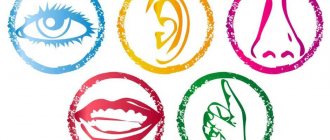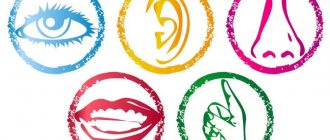Basic functions of emotions
Reflective-evaluative function. The significance of objects and situations that are necessary to achieve goals and satisfy human needs is assessed using emotions. Emotions are a system of signals that makes it possible to understand the significance of events.
Incentive function. By assessing what is happening, a person motivates himself to take some action. S.L. Rubinstein argued that emotion contains attraction, desire, desire, directed towards an object or away from it.
The activating function has a close connection with the incentive function. Emotions provide the necessary level of activity of the human central nervous system. The dynamics, tempo, and rhythm of activity are influenced by various emotional states. Positive emotions, such as joy and confidence, add dynamics to activity processes and encourage a person to take active, intense actions. Scientist D. Hebb has proven the dependence of the effectiveness of human activity on the level of his emotional state. Hebb calls this dependence curvilinear, “bell-shaped.” To achieve high performance results, you need to have an optimal level of emotional arousal. Too weak and very strong emotional states are undesirable. The optimal level ensures maximum efficiency in the process of activity. It depends on the conditions of the activity performed, the individual properties of the person involved in the activity.
Note 1
If emotions are weak, then the person has insufficient motivation. If emotions are too strong, a person becomes disorganized and uncontrollable, which destroys activity.
Regulatory function. Emotions regulate and direct human activity, limiting or, on the contrary, expanding it. When an emotional attitude towards an object arises, it affects the motivation of activity at all its stages. With the help of emotions, a subjective assessment of what is happening is given. This means that the same event can be emotionally perceived differently.
Synthesizing function. Individual events and facts are built into one whole with the help of emotions. Scientist A.R. Luria proved that many images that are directly or indirectly associated with an object that gave rise to a strong emotional experience are combined into a stable complex in the human mind. If one element is actualized, other components of this complex are reproduced in consciousness, sometimes even against the person’s desire.
Meaning-forming function. Human actions gain meaning through emotions. A.N. Leontyev argued that successful actions performed during the day may not satisfy a person and even spoil his mood. The negative aftertaste will be barely noticeable against the background of worries throughout the day. But when a person begins to mentally analyze the day he has lived, a certain event appears in his memory. The mood acquires an objective correlation, a signal appears indicating an event that left unpleasant sensations. This could be a negative reaction to someone else doing something more successful. The man thought and acted correctly, as it seemed to him, and this was the main motive of his activity, but in reality it did not turn out quite like that.
Protective function. Strong emotional experiences, such as fear, send a signal to a person that there is danger and encourage him to think carefully about his actions. That is, fear is a person’s protection from unpleasant consequences.
Expressive function. All emotions contain an expressive component. Through it, a person establishes relationships with other people.
The question of the functions of emotions has been developed by many scientists; there are several classifications, including Simonov, Leontiev, Wundt.
The importance of emotions is enormous in human life. Scientists, psychologists, have found it necessary to clearly differentiate them. The German philosopher I. Kant identified two types of emotional states according to the degree of activation: sthenic and asthenic emotions.
Thenic emotions cause an increase in human activity, while asthenic ones, on the contrary, reduce it. Emotions can be positive and negative, intense, long-lasting, conscious and unconscious.
Note 2
Human emotions can be distinguished by modality and quality of experience.
Psychologist K. Izard identifies ten main emotions, three of them are positive, seven are negative.
Block 4. Emotions. Anger.
Anger is a negative emotional state, most often occurring in the form of affect, caused by sudden circumstances that block the satisfaction of a need that is absolutely important for a person.
It is not at all necessary that the circumstances occur in reality; anger may arise as a result of one’s own conclusions.
The causes of anger are very different.
1. It could be a “traffic jam” on the road, due to which a person is late for his business, i.e. obstacles and blocks arise that prevent you from gaining access to target resources.
2. In a “traffic jam” on the road, a neighboring driver can make a dangerous maneuver and block a person’s car, after which he can jump out of the cabin of his own “four-wheeled friend” with the intention of punishing the “offender” and rush to the enemy’s car. As a result, the target person categorizes events as a threat to his property or even health, life, and he himself rushes with a gun at the potential offender in anger. Anger comes from threat.
3. In the same traffic jam, a driver passing by may call a person an offensive bad word, which will be perceived as an insult and will also cause anger.
4. The car in front, instead of moving in a straight direction, because there is a gap in the traffic jam, continues to “cling to the wheels” of the place. The driver begins to feel angry towards the “slow motorist” because the situation seems inadequate and does not meet expectations.
5. In a traffic jam, the driver of a neighboring car can shout loudly, being in a state of anger and “infect” other drivers with his condition as if with a virus.
6. A car passing by at speed can splash mud on a person’s just washed “iron horse,” which will again cause anger, since a relatively comfortable state is disrupted.
7. A luxury car with prestigious license plates driving in the same direction in the oncoming lane, avoiding a traffic jam, is also capable of causing anger with its “unfair behavior” and claims to exclusivity.
8. Finally, anger can be directed against oneself when a person finds himself in a traffic jam, instead of looking at an electronic map in advance on his smartphone that displays the current traffic situation and choosing a different path.
Anger can also be represented in different ways:
– Rage is the highest manifestation of anger. A person almost loses the ability to control his own behavior.
– Anger/anger itself is a person’s experience of strong tension, accompanied by a desire to destroy the cause that gave rise to discomfort.
– Indignation is a person’s experience of injustice towards himself and “THIS OWN”.
– Resentment is a mild form of anger . This experience usually arises as a person’s reaction to a stimulus, which is not realized “HERE AND NOW” in a worthy response to the offender. A protracted character arises. This is anger extended over time.
What are emotional states
In psychology, the concept of “emotions” is used both in a broad sense, as emotional states, and in a narrow sense, as one of the types of these states, along with feelings, moods, affects, etc. Emotional states are a special class of mental phenomena that reflect attitudes man to the world.
Emotions and needs
Interacting with the world around us and with other people, a person constantly encounters situations that evoke different attitudes in him: joy or indignation, sadness or hatred, surprise or sympathy. That is, a person reflects the world and stores information in memory not only in images and concepts, but also in the form of sensory experiences - emotions.
Emotions are closely related to human needs. Those life circumstances, situations or people that contribute to the satisfaction of needs cause us positive emotions, and those that interfere or hinder us cause negative emotions. It's so simple and complicated at the same time.
- Firstly, we are not always aware of our needs, but we always experience the emotions associated with them. Therefore, we often cannot even explain to ourselves why we don’t like this or that person, or why our mood suddenly deteriorated.
- Secondly, a person lives a complex and multifaceted life, and often his needs come into conflict not only with the needs of other people, but also with his own desires. Therefore, understanding this confusing and chaotic whirlpool of emotions can be extremely difficult even for an experienced psychologist. You probably know that you can love and hate the same person at the same time, or be afraid and look forward to some event at the same time.
You can deal with your experiences only by realizing and bringing your confused desires and needs into at least relative order. Experienced psychotherapists can help a person with this. After all, only by understanding and accepting your needs or consciously abandoning them can you reduce the severity of negative experiences.
Psychophysiology of emotional states
Emotions are the oldest type of mental states; animals have them and are associated with the satisfaction of natural, and in higher animals, social needs.
- The antiquity of this type of mental state is confirmed by the fact that they are born in the old, from an evolutionary point of view, subcortical part of the brain - in the limbic system. By the way, the name is very telling. Limbo is purgatory, a place between heaven and hell, and even deeper lurks animal instincts and hidden, often dark desires and needs. They sometimes break through from the subconscious level, awakening in us strange emotions that frighten even ourselves.
- But the expression of emotions is controlled and controlled by the “youngest” and most rational part of the brain – the neocortex (“new cortex”). And when the rational part of the brain turns off, for example, during severe alcohol intoxication or in a state of passion, then emotions go out of our control, and behavior begins to be controlled by instincts, not reason.
Any external influence causes a focus of excitation in the cerebral cortex. If the irritation is weak, then the focus quickly fades, but the stronger the impact, the larger and more stable this focus is. Penetrating into the subcortical zone, it activates the centers of emotions.
Emotions, in turn, cause various changes in the physiological systems of the body, because emotions are a signal about the nature of the impact of the stimulus. And if they are negative, then our body is rebuilt, preparing to repel danger or run away from it. Moreover, for our brain, it turns out, it doesn’t matter whether the enemy is real or imaginary - the signal to restructure the body’s functioning is still received, and we experience various, often unpleasant, sensations. Thus, the emergence of a feeling of fear is accompanied by the following processes:
- Adrenaline is released into the blood, which should increase the supply of oxygen to the muscles and activate the sympathetic nervous system;
- blood and nutritional resources are directed to support the muscular system; this reduces the supply to other body systems, so a person feels cold, chills, his face turns pale, and due to lack of blood supply, dizziness and even loss of consciousness may occur;
- in order to cope with the increased needs for blood supply, the heart begins to beat faster, breathing quickens to supply the blood with oxygen and, as a result, difficulties arise with speech;
- rational control over behavior decreases, since the functions of the cerebral cortex are somewhat suppressed, and the person literally becomes stupid and does not think rationally well.
Changes in the functioning of various body systems under the influence of emotions are reflexive in nature, so we cannot consciously control them, but we can control emotions, at least at the initial stage of their occurrence. Our brain is quite capable of “persuading” the body not to succumb to feelings of fear or anger. And in psychotherapy there are special techniques and trainings that allow a person to learn to manage their emotions even in the most critical situations.
Managing emotions is necessary not only to regulate behavior, but also to maintain physical health. The fact is that negative feelings (and they are experienced more strongly by a person than positive ones) have very unpleasant consequences. Their systematic experience can lead to the development of psychosomatic diseases, primarily of the cardiovascular and digestive systems. It is these systems that are most affected by adrenaline surges and other physiological changes. That is, the saying: “All diseases come from nerves” has a rational basis.
How to express your emotions correctly?
The question of how to learn to express your emotions is very important. Emotions are a type of energy that accumulates inside us. The accumulation of this energy leads to emotional tension and ultimately an emotional-bodily block. Over time, consequences such as problems with the nervous system and general health may occur.
For example, aggression and internal anger can reach such a peak that a person becomes dangerous. These are the situations in which you need to understand how to express negative emotions. If you manage to recognize such an emotional state in yourself, there are several ways to cope with it:
- Calm down and slowly count to 100. As a rule, after this half of what you want to do seems somehow unthinkable and unhealthy. This method will help you avoid unpleasant situations and learn to react more calmly to difficult situations, as well as show emotions more correctly;
- Share your emotions with other people. Tell them that you are sad or have problems. During the conversation, relief will definitely come;
- Allow yourself to cry, even in front of the mirror. Tears help relieve internal and emotional stress. They also show others that you are in pain;
- Dancing or singing is a great way to release pent-up emotions. You can sing and dance in a group or alone.
Have you ever felt irritated by what other people are experiencing?
Yes. I am often irritated by other people's emotions, especially by other people's attempts to express them.
14.29%
Yes, but this happens rarely. Mainly when it comes to uncontrolled display of bad or good mood.
71.43%
No, it doesn't bother me at all.
0%
No, I am calm about the expression of feelings by others, sometimes with approval.
14.29%
Voted: 7
Fundamental human emotions
Interest-excitement. An emotion that a person experiences more often than others. The importance of this emotion for motivation in developing skills and acquiring knowledge should be emphasized. Interest opens the way to curiosity, exploration, and expansion of experience. If the interest is intense, the person is in a state of inspiration and revitalization.
Joy can be characterized by feelings of confidence, significance, enjoyment and satisfaction. A person is satisfied with himself and the world around him, he feels strength and energy. Joy is a feeling that arises when achieving something, realizing one’s abilities, satisfying one’s desires.
Astonishment. The peculiarity of this emotion is that it arises quickly and passes just as quickly. This is a transitory emotion. Surprise cannot be a motive for behavior over a long period. The function of this state is to prepare a person for subsequent actions, for new events.
Suffering. One of the most common negative emotions. It is dominant in grief and depression. There are many reasons for suffering. These are problems of everyday life, states of need. When describing suffering, they note loss of spirit, loneliness, isolation, despondency. The emotion signals to the person and his environment that he is feeling bad. Emotion prompts a person to take actions that alleviate this condition and eliminate the cause of suffering. The most severe form of suffering is grief. The source of grief is loss. The state of grief is very difficult for a person to experience.
Anger. A very strong negative emotion. Anger arises as a result of non-realization, failure to achieve what is passionately desired. The causes of anger can be: personal insult, deception, coercion. When a person experiences anger, he feels his strength and feels the desire to crush the source of anger. The greater the intensity of the anger, the stronger the subject and the greater his desire to physically act. Rage is the highest manifestation of this emotion. Here the mobilization of energy is so great that a person is forced to throw out this energy. This manifests itself in various ways.
Disgust. This emotion occurs when a person seeks to eliminate or change an object. In the human mind there is a mismatch between the value-significant and the ugly-imperfect. Disgust can be caused by objects, actions, and actions. Like anger, this emotion can be directed at oneself, then self-esteem decreases and a feeling of self-condemnation arises.
Contempt. If a person experiences this emotion, then he should feel smarter, stronger, more confident than the despised person. The person experiences a sense of superiority and devalues the qualities of others. It's a hostile feeling. A person is hostile to someone he despises.
Fear. A strong and dangerous emotion. The cause of fear can be an event, a condition that signals danger. This emotion controls a person’s consciousness and behavior. He can experience a state of fear as a premonition of trouble, uncertainty, insecurity, a threat to his existence. There are many types of fear: from unpleasant foreboding to horror.
Shame. When experiencing a feeling of shame, a person seems to be small, constrained, upset, and worthless. Emotion paralyzes mental activity, a person is deprived of the opportunity to think logically for some time. Shame can cause feelings of self-loathing.
Guilt. An emotional state resulting from wrong actions. A person feels guilty when he realizes that he has violated the rules, that he has crossed the boundaries of something. Guilt can arise in connection with condemnation of one's action. Reactions to feelings of guilt include remorse, self-condemnation, and lowered self-esteem. When a person is personally responsible for something, a feeling of guilt arises. This emotion is long-lasting and painful.
Cognitive content
According to this classification, feelings are divided into simple and complex. The first ones are fast and bright (anger, joy). They occur momentarily, immediately upon encountering a factor that motivates them (for example, when a guy invites a girl on a date, she rejoices). The second ones are longer and often contradictory (after receiving an invitation, she begins to analyze the situation and doubt).
What are the different emotions?
Positive and negative basic human emotions make up a relatively small list of ten manifestations:
- Joy;
- Sadness;
- Disgust;
- Astonishment;
- Anger;
- Guilt;
- Fear;
- Interest;
- Shame;
- Contempt.
The classification of emotions involves the emotions themselves and the feelings themselves. In addition, it is customary to distinguish additional mental states: passion, affect, stress, mood. All human emotions make up a much larger list. It includes different aspects of fear, pleasure, anger. We can say that in the human community, with the development of the mental sphere, gradations of basic emotions appeared, which began to be called feelings.
What are the emotions a person has, list:
- Excitement;
- Despair;
- Fury;
- Safety;
- Anxiety;
- Gratitude;
- Sorrow;
- Satisfaction;
- Disgust;
- Astonishment;
- Anger;
- Guilt;
- Dejection;
- Delight;
- Anxiety;
- Arrogance;
- Shame;
- Pride;
- Fear;
- Sadness;
- Calm;
- A pity;
- Confusion;
- Gloat;
- Compassion;
- Interest;
- Boredom;
- Irritation;
- Hope;
- Disappointment;
- Tenderness;
- Lust;
- Hatred;
- Contempt;
- Dislike;
- Joy;
- Sadness;
- Sadness;
- Disgust;
- Resentment;
- Disgust.
Some of them are close to each other in sensations and manifestations, related mental states. But due to emotional development, a person is able to separate fear and caution, tenderness and lust. Some researchers include in the list such manifestations as: hunger, thirst, fatigue. These concepts are not emotions, they appear as a result of signals to the brain that are sent by the body's receptors. But the anger, indignation and resentment that arise as a result of these sensations can already be safely called emotions.
Positive emotions
We ourselves put a plus or minus sign in front of any emotion. This is actually a very subjective assessment. Any emotion is a physiological response to a stimulus (internal or external). To be precise, this applies to those manifestations due to which the so-called “pleasure hormone” is produced.
Therefore, the list of positive human emotions given below is also conditional:
- Joy;
- Love;
- Interest;
- Satisfaction;
- Calm;
- Tenderness;
- Surprise (questionable);
- Lust.
Characteristics of positive emotions: what is commonly called positive causes pleasure. If the cause is external, then a person strives for it again and again. If it is inside, then an instinctive desire arises to resume the state that causes the release of endorphins. This is how attachments of dependence on something or someone that causes pleasure arise (objects of art, pets, a loved one).
Even positive emotions have a dark side. A maniac and murderer, rapist, torturer of his victims takes pleasure in his perverted activities. The use of narcotic drugs, alcohol, and psychotropic drugs causes artificial bursts of joy and pleasure, becoming the cause of addiction, which is extremely difficult to overcome.
Even fish can show positive emotions. When they see a potential partner, they show their interest by showing it through their behavior. “Body language” is used by all living beings, although the range of emotions and their depth differ depending on what stage of evolution they are at. At the moment, humans are considered the most developed mammal, although recently they are increasingly saying that dolphins may supplant us on this pedestal.
Strong emotions provoke the release of adrenaline into the blood, regardless of whether they are positive or negative. If there is too much shock (feeling of danger), there is so much of it that the body is not able to cope with the huge dose, the psyche is in a state of stress, and the body is ready for active action, while consciousness may be clouded.
In this case, it is customary to talk about a state of affect. Positive emotions help produce oxytocin (pleasure hormone), dopamine and endorphin (happiness hormones). If something frightening and joyful happens at the same time (for example, childbirth), then the blood turns into a “chemical cocktail” oversaturated with various hormones.
Each of them plays a role in maintaining the vitality of the body. This is how the evolutionary mechanism inherent in us by nature works.
To obtain positive emotions, you can use the properties of the physical body. For this you can use:
- Moderate physical activity. A walk in nature, around the city. Not too tiring work, jogging, dancing - all these actions contribute to the production of endorphins. Especially if all this happens in the fresh air in a beautiful place that can bring aesthetic pleasure.
- Favorite hobby. Doing something enjoyable also helps lift your mood.
- Watching a movie or reading a book. A good work of art deeply touches our feelings, and can even cause catharsis - emotional release through deep emotions, tears. This is a good “reboot” for the body.
- Communication with pets. Cats, dogs, and other animals can relieve stress, help you relax and bring a lot of positive emotions with their behavior and even their simple presence.
- Doing good deeds. We are not talking about something global. Small pleasant things that bring pleasure to others resonate in the same way within ourselves. Seeing joy on the face of another person, we receive a non-verbal signal and, against our will, mirror a good mood.
That's why they talk about "infectious laughter", "infectious positivity" and an involuntary improvement in mood in the presence of someone experiencing joy. Joy can be shared, but grief can be infected precisely for this reason - we perceive signals on a subconscious level and project them onto ourselves. Even a drawing (a smiley face) that conveys a mood has a subtle impact.
Negative emotions
The list of a person’s negative emotions is also conditional. “Bad” feelings should be treated as a defense mechanism that has been developed over thousands of years. That is why there is no need to reproach yourself for fear or be ashamed of feeling anxious. However, it is worth remembering that negative emotions encourage certain actions, bad deeds. This is what you need to work with.
If you experience a flash of anger, it is natural and will pass over time, but fighting, insulting, or even more severe actions under the influence of this emotion are something that you need to be able to control.
Destructive emotions have a destructive effect on the psyche and nervous system. These include:
- Sadness;
- Sadness;
- Dejection;
- Stress;
- Fury;
- Anger;
- Fear;
- Depression.
All these manifestations can significantly worsen health if a person experiences them for a long time. This is explained simply by the same chemical reactions.
The body responds by releasing certain substances into the blood that increase blood pressure, increase alertness, and give strength. But they all work only with short-term exposure. Prolonged and prolonged entry into the blood causes a condition close to poisoning. Active substances break down, releasing toxins. If there are too many of them, then the body simply cannot cope and receives the command to “die”. Therefore, negative and destructive emotions are more dangerous than they might seem. These are not just thoughts in the head, it is a process in which the whole body is involved.
The list of emotions that are commonly called negative:
- Fear;
- Resentment;
- Aggression;
- Anger;
- Gloat;
- Jealousy;
- Dejection;
- Sorrow;
- Yearning;
- Disgust;
- Confusion.
This list can be supplemented, since in human language there are many names for feelings and experiences that can also be called emotions. I left only the main ones, those that, in my opinion, have the most ancient origin and are closely related to physiology.
Human Emotions Chart
| Positive emotions | Negative emotions |
| Joy | Fear |
| Love | Resentment |
| Interest | Aggression |
| Satisfaction | Anger |
| Calm | Gloat |
| Tenderness | Jealousy |
| Astonishment | Dejection |
| Lust | Sorrow |
| Yearning | |
| Disgust | |
| Confusion |
Mood
Mood is a prolonged emotional state of average intensity, a certain emotional background for mental processes. This is also a state that characterizes a certain object, its mood (picture, melody).
Affect and stress
Affect is an emotional state of an explosive nature, short-term, intense, with a pronounced change in motor processes and the functioning of internal organs. It is an unconscious assessment of a given situation. It is characterized as severe emotional disturbance.
In a moment of passion, a person may say too much
Response scale
This technique is a questionnaire of 25 statements that determines the degree of development of empathy in an individual.
The person taking the test needs to rate his/her agreement: always, often, rarely, never.
| № | Judgment | Answer | |||
| IN | H | R | N | ||
| 1 | I feel sad when I see someone feeling lonely in company. | ||||
| 2 | When those around you cannot restrain themselves and openly show their emotions, it is unpleasant. | ||||
| 3 | When a person gets excited next to me, I feel the same. | ||||
| 4 | I believe that tears of happiness are stupid. | ||||
| 5 | I also experience the troubles of my friends. | ||||
| 6 | Sometimes love songs make me sensitive. | ||||
| 7 | I would be very worried if I had to convey bad news to anyone. | ||||
| 8 | My condition is greatly influenced by my environment. | ||||
| 9 | I would like to have a job that involves communication. | ||||
| 10 | I love seeing people receive gifts. | ||||
| 11 | When I see/hear that a person is crying, I get upset myself. | ||||
| 12 | Listening to certain music makes me feel happy. | ||||
| 13 | When I read a work of fiction, I worry so much, as if all this is happening in reality. | ||||
| 14 | I get angry when I see a person being treated horribly. | ||||
| 15 | I can remain calm even when everyone around me is panicking. | ||||
| 16 | It makes me nervous when people shed tears. | ||||
| 17 | When I make a decision, no one else's opinion usually matters. | ||||
| 18 | I also get angry when people around me are worried about something. | ||||
| 19 | I get worried if I see people worrying about trifles. | ||||
| 20 | I get worried when I see animals suffering. | ||||
| 21 | It's stupid to worry about what happens in a book or movie. | ||||
| 22 | I feel sad when I see weak people. | ||||
| 23 | I get very emotional when watching a film. | ||||
| 24 | I can be indifferent to any disturbance going on around me. | ||||
| 25 | Children cry for no serious reason. | ||||
Ask a question
Results
| № | Number of points per answer | |||
| B – I agree (always) | H - often | R - rarely | N - never | |
| 1 | 4 | 3 | 2 | 1 |
| 2 | 1 | 2 | 3 | 4 |
| 3 | 4 | 3 | 2 | 1 |
| 4 | 1 | 2 | 3 | 4 |
| 5 | 4 | 3 | 2 | 1 |
| 6 | 4 | 3 | 2 | 1 |
| 7 | 4 | 3 | 2 | 1 |
| 8 | 4 | 3 | 2 | 1 |
| 9 | 4 | 3 | 2 | 1 |
| 10 | 4 | 3 | 2 | 1 |
| 11 | 4 | 3 | 2 | 1 |
| 12 | 4 | 3 | 2 | 1 |
| 13 | 4 | 3 | 2 | 1 |
| 14 | 4 | 3 | 2 | 1 |
| 15 | 1 | 2 | 3 | 4 |
| 16 | 1 | 2 | 3 | 4 |
| 17 | 1 | 2 | 3 | 4 |
| 18 | 4 | 3 | 2 | 1 |
| 19 | 4 | 3 | 2 | 1 |
| 20 | 4 | 3 | 2 | 1 |
| 21 | 1 | 2 | 3 | 4 |
| 22 | 4 | 3 | 2 | 1 |
| 23 | 4 | 3 | 2 | 1 |
| 24 | 1 | 2 | 3 | 4 |
| 25 | 1 | 2 | 3 | 4 |
| Sum | ||||
Now calculate the results:
- 11 points - extremely reduced level of empathy;
- 12-36 - low;
- 37-62 - normal;
- 63-81 - high;
- 82-90 - elevated.
How are feelings different from emotions?
Close in meaning, but still not identical, are the concepts of emotions and feelings. In scientific psychology, these terms define different components of a single emotional background.
Feelings are deeper states that determine a person’s stable attitude to surrounding events. They are often less pronounced and have smoothed manifestations. Emotions are a reaction-outburst to a specific situation, causing vivid manifestations, often born unconsciously. In psychology, feelings are more conscious manifestations of attitudes towards a particular object. A person can experience the whole gamut of emotions, but at the same time not show feelings if there are no prerequisites for this. For example, do not hate an enemy if the enemy does not exist. At the same time, show anger if something served as a reason for this.
The feelings inherent in a particular person are significantly influenced by the society surrounding the space. Emotions are a subjective assessment based on an internal understanding of reality and the characteristics of the nervous system.
Types of feelings
In fact, this part of the perception of the environment is difficult to classify, since it is multifaceted and diverse. Conventionally, psychology defines the following types of feelings:
- moral;
- intellectual;
- practical;
- aesthetic.
| Category | Subcategory | Manifestations | Characteristic |
| Moral | Moral | Humanity | Relationships between people, attitudes towards one’s own position in society, determination of acceptable behavior, the limits of what is permitted. |
| Patriotism | |||
| Call of Duty | |||
| Love | |||
| Immoral | Cruelty | ||
| Selfishness | |||
| Hatred | |||
| Greed | |||
| Intelligent | Specific | Inspiration | Determine attitude to intellectual needs. |
| Determination | |||
| Thirst for knowledge | |||
| Satisfaction from new knowledge and discoveries | |||
| Nonspecific | Curiosity | ||
| Astonishment | |||
| Humor | |||
| Irony | |||
| Praxic | Choice of activity | Profession | They determine the attitude towards everyday worries, responsibilities, and relationships with society. |
| Favorite leisure activity | |||
| Interesting activities | |||
| Aesthetic | Satisfaction from seeing, touching, listening | Love for nature | Determine the range of interests aimed at satisfying aesthetic needs |
| Love for technology | |||
| Favorite music | |||
| Works of art, architecture, sculpture |
There are more complex feelings that cannot be clearly attributed to one of the types. For example, love awakens a person to strive for knowledge, to reveal aesthetic potential, inspires, and determines the choice of activity.
How to learn to control your emotions?
You can find a sufficient amount of information on this topic in books on psychology and on the Internet. The most effective techniques include:
Rule #1 . Change your attitude towards emotions.
This is your condition, accept it with love. It is completely normal that you are experiencing them. In addition, you simply need them, this is scientifically proven. No matter what their character is, positive or negative, do not hold them unless the situation, the rules of society and the environment at the moment require it.
Rule #2. Try to experience your emotions to the maximum.
Even if there is a hurricane of emotions inside you, the only reason for holding them back can be an inappropriate environment. To throw out, for example, your rage and indignation at some kind of injustice that brings you to this state, just find a place where you can retire and no one can disturb you. Let it be, for example, your car.
Talk through everything that worries you, shout, free yourself from what you have accumulated, you can even cry - this is very effective.
In other words, just embrace your emotion as much as possible and “wave your hand at it.” You will certainly feel relief and return to a calm, objective assessment of the problem in order to effectively solve it. It is even possible that after such a release it will seem trivial to you and not requiring attention.
Rule #3. Develop your ability to recognize and manage your emotions.
When emotions overwhelm you again, try to understand what they express, which one you are experiencing, give it a specific name. Try to feel the full spectrum of what you are experiencing. Observe your reactions to this emotion. Perhaps the range of what you experience with it will expand each time.
If you do this kind of work constantly, over time you will begin to notice that your emotional perception has acquired a deeper and more acute character, and you will begin to experience subtle feelings. Your music will be more beautiful, your films will be more profound, your works of art will be more magnificent.
Rule #4. Sometimes swear, but in a good way.
The technique is simple. Each of us has encountered in life such people whom we want not only to scold, but simply to destroy. If your patience is full and you are ready to explode, just step aside and try to calm down. There is no need to avoid conflict or push your emotions deep inside. Just return to the dialogue later and sort out your complaints with your opponent.
Managing Emotions
Management is needed in order to overcome barriers to communication and mutual understanding. Many people believe that uncontrollable emotions need to be suppressed, although this is not the answer. A psychologist will help in their management. The support of friends and loved ones is important.
One individual experiences different feelings towards a certain object, sometimes contradictory. Another person is suffering from uncontrollable emotions and needs help. Emotionality occupies an important place in psychology due to the fact that people differ in this quality from other living beings.
Block 6. Emotions. Contempt.
Contempt is a negative emotional state characteristic of interpersonal relationships that occurs when there is a divergence in assessments, convictions and beliefs regarding an object or phenomenon.
Thus, an arrogant person treats with contempt people who do not correspond to his idea of what one should be. The manifestation of timidity can cause contempt on the part of a subject who holds the view that timidity is the lot of the weak, and the weak are a lower “caste”.
A person identifies one or two key criteria that serve as a template for other people. This is a kind of “Procrustean bed” when everything unimportant is “cut off”. A person may not be able to defend his position, he may speak intelligently and softly, and be despised for this.
What are feelings for?
The functions of feelings in psychology are determined by their ability to leave information about significant events and objects.
- reflective - an assessment of what is happening in order to determine the degree of danger in order to find ways to prevent it;
- stimulating - feelings encourage you to look for ways to solve certain problems and determine goals for the future;
- reinforcing - thanks to feelings, a person remembers significant events, giving his own subjective assessment;
- switching - help set priorities, determine more important objects, actions, decisions. In other words, it is willpower;
- adaptive - based on previously experienced feelings, a person can more easily adapt to a new reality;
- communicative - the language of feelings is one of the effective ways to interact with others.
Sources
- https://Zaochnik.com/spravochnik/psihologija/obschaja-psihologija/funktsii-i-osnovnye-vidy-emotsij/
- https://psychologist.tips/1086-emotsii-i-chuvstva-v-psihologii-sushhnost-vidy-funktsii-chem-otlichayutsya-emotsii-ot-chuvstv.html
- https://psylib.org/emocii/
- https://srazu.pro/teoriya/emocii-v-psixologii.html
- https://ProPanika.ru/psihologiya/psihologiya-emotsij-i-vidy-chuvstv/
[collapse]Tweet Pin It











